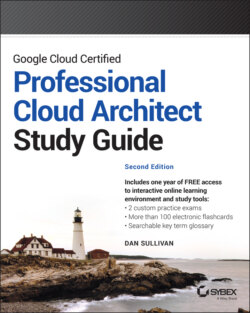Читать книгу Google Cloud Certified Professional Cloud Architect Study Guide - Dan Sullivan - Страница 52
Chapter 2 Designing Solutions to Meet Business Requirements
ОглавлениеTHE PROFESSIONAL CLOUD ARCHITECT CERTIFICATION EXAM OBJECTIVES COVERED IN THIS CHAPTER INCLUDE THE FOLLOWING:
1.1 Designing a solution infrastructure that meets business requirements
1.2 Designing a solution infrastructure that meets technical requirements
1.5 Envisioning future solution improvements
One of the things that distinguishes a cloud architect from a cloud engineer is the architect's need to work with business requirements. Architects work with colleagues responsible for business strategy, planning, development, and operations. Before architects can begin to design solutions, they need to understand their organization's cloud vision and objectives that the business is trying to achieve. These objectives frame the possible solutions that are acceptable to the business.
When it comes to the Professional Cloud Architect exam, business requirements are pieces of information that will help you determine the most appropriate answer to some of the questions. It is important to remember that questions on the exam may have more than one answer that appears correct, but only one answer is the best solution to the problem posed. For example, a question may be asked about a small business application that needs to store data in a relational database, and the database will be accessed by only a few users in a single office. You could use the globally scalable relational database Cloud Spanner to solve this problem, but Cloud SQL would be a better fit to the requirements and cost less. If you come across a question that seems to have more than one answer, consider all the technical and business requirements. You may find that more than one option meets the technical or the business requirements, but only one option meets both.
This chapter reviews several key areas where business requirements are important to understand, including the following:
Business use cases and product strategy
Application design and cost considerations
Systems integration and data management
Compliance and regulations
Security
Success measures
Throughout the chapter, I will reference the case studies used in the Google Professional Cloud Architect exam.
